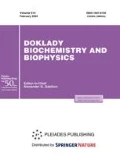Abstract
Infection of mice with influenza A viruses led to the formation of clones of lymphocytes that specifically recognizes viral domains in the central zone of the NSP protein (amino acid positions 83–119). Computer analysis of the primary structure of the NSP protein showed the presence of T-cell epitopes in the central part of the NSP molecule. The findings indicate that the viral NSP gene is expressed in the infected animals and verify the concept of the bipolar strategy (ambisense strategy) of the influenza A virus genome.



Similar content being viewed by others
REFERENCES
Dou, D., Revol, R., Ostbye, H., Wang, H., and Daniels, R., Influenza A virus cell entry, replication, virion assembly and movement, Front. Immunol., 2018, vol. 9, p. 1581. https://doi.org/10.3389/fimmu.2018.01581
Palese Baez, M., Zazra, J.J., Elliott, R.M., Young, J.F., and Palese, P., Nucleotide sequence of the influenza A/duck/Alberta/60/76 virus NS RNA: conservation of the NS1/NS2 overlapping gene structure in a divergent influenza virus RNA segment, Virology, 1981, vol. 113, no. 1, pp. 397–402.
Zhirnov, O.P., Poyarkov, S.V., Vorob’eva, I.V., Safonova, O.A., Malyshev, N.A., and Klenk, N.D., Segment NS of influenza A virus contains an additional gene NSP in positive-sense orientation, Dokl. Biochem. Biophys., 2007, vol. 414, pp. 127–133. PMID .17695319
Zhirnov, O.P., Vorobjeva, I.V., Saphonova, O.A., Poyarkov, S.V., Ovcharenko, A.V., Anhlan, D., and Malyshev, N.A., Structural and evolutionary characteristics of HA, NA, NS, and M genes of clinical influenza A/H3N2 viruses passaged in human and canine cells, J. Clin. Virol., 2009, vol. 45, no. 4, pp. 322–333. https://doi.org/10.1016/j.jcv.2009.05.030
Zhirnov, O.P., Akulich, K.A., Lipatova, A.V., and Usachev, E.V., Negative-sense virion RNA of segment 8 (NS) of influenza A virus is able to translate in vitro a new viral protein, Dokl. Biochem. Biophys., 2017, vol. 473, pp. 122–127. https://doi.org/10.1134/S1607672917020090
Clifford, M., Twigg, J., and Upton, C., Evidence for a novel gene associated with human influenza A viruses, Virol. J., 2009, vol. 6, p. 198. https://doi.org/10.1186/1743-422X-6-198
Gong, Y.N., Chen, G.W., Chen, C.J., Kuo, R.L., and Shih, S.R., Computational analysis and mapping of novel open reading frames in influenza A viruses, PLoS One, 2014, vol. 9, no. 12. e115016. https://doi.org/10.1371/journal.pone.0115016
Yang, C.W. and Chen, M.F., Uncovering the potential pan proteomes encoded by genomic strand RNAs of influenza A viruses, PLoS One, 2016, vol. 11, no. 1. e0146936. https://doi.org/10.1371/journal.pone.0146936
Sabath, N., Morris, J.S., and Graur, D., Is there a twelfth protein-coding gene in the genome of influenza A? A selection-based approach to the detection of overlapping genes in closely related sequences, J. Mol. Evol., 2011, vol. 73, nos. 5–6, pp. 305–315. https://doi.org/10.1007/s00239-011-9477-9
Jensen, K.K., Andreatta, M., Marcatili, P., Buus, S., Greenbaum, J.A., Yan, Z., Sette, A., Peters, B., and Nielsen, M., Improved methods for predicting peptide binding affinity to MHC class II molecules, Immunology, 2018, vol. 154, no. 3, pp. 394–406. https://doi.org/10.1111/imm.12889
Bhasin, M. and Raghava, G.P.S., A hybrid approach for predicting promiscuous MHC class I restricted T cell epitopes, J. Biosci., 2006, vol. 32, pp. 31–42.
Jameson, B.A. and Wolf, H., The antigenic index: a novel algorithm for predicting antigenic determinants, Comput. Appl. Biosci., 1988, vol. 4, no. 1, pp. 181–186.
Panthu, B., Terrier, O., Carron, C., Traversier, A., Corbin, A., Balvay, L., Lina, B., Rosa-Calatrava, M., and Ohlmann, T., The NS1 protein from influenza virus stimulates translation initiation by enhancing ribosome recruitment to mRNAs, J. Mol. Biol., 2017, vol. 429, no. 21, pp. 3334–3352. https://doi.org/10.1016/j.jmb.2017.04.007
Zhong, W., Reche, P.A., Lai, C.C., Reinhold, B., and Reinherz, E.L., Genome-wide characterization of a viral cytotoxic T lymphocyte epitope repertoire, J. Biol. Chem., 2003, vol. 278, no. 46, pp. 45135–45144.
Nguyen, M. and Haenni, A.L., Expression strategies of ambisense viruses, Virus Res., 2003, vol. 93, no. 2, pp. 141–150.
Funding
This work was partially supported by the Russian Foundation for Basic Research (project nos. 16-04-01271, 13-04-001824) and the Scientific Program SFB 293 of the German Research Society (DFG).
Author information
Authors and Affiliations
Corresponding author
Ethics declarations
Conflict of interests. The authors declare that they have no conflict of interest.
Statement on the welfare of animals. All applicable international, national, and/or institutional guidelines for the care and use of animals were followed.
Additional information
Translated by M. Batrukova
Rights and permissions
About this article
Cite this article
Zhirnov, O.P., Isaeva, E.I. NSP Protein Encoded in Negative NS RNA Strand of Influenza A Virus Induces Cellular Immune Response in Infected Animals. Dokl Biochem Biophys 486, 201–205 (2019). https://doi.org/10.1134/S1607672919030128
Received:
Published:
Issue Date:
DOI: https://doi.org/10.1134/S1607672919030128



